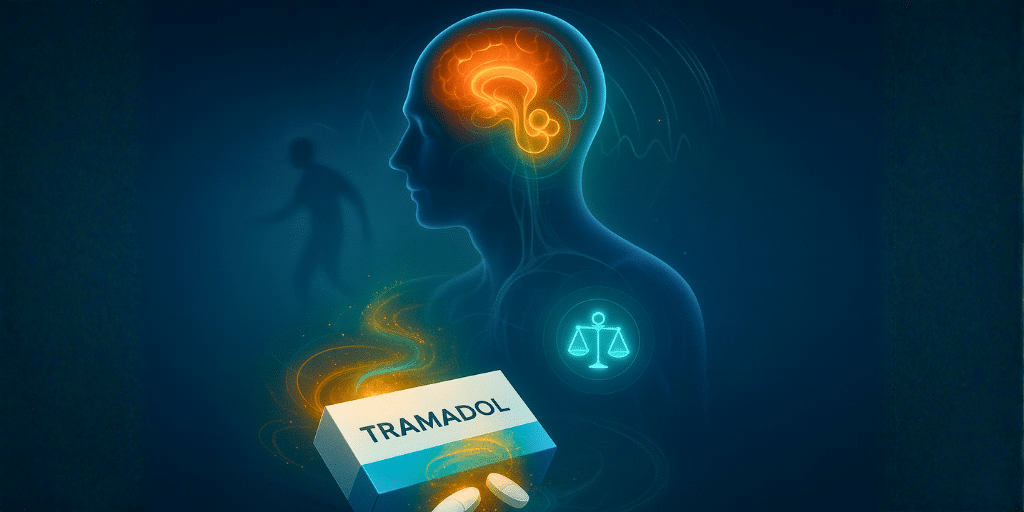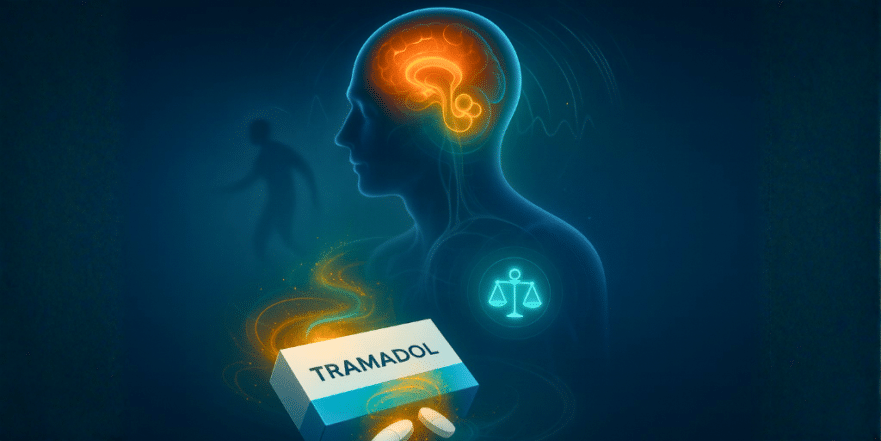
Imagine a waiting room with five people over the age of 60. Statistically speaking, at least one of them is likely taking tramadol for pain. It’s an incredibly common painkiller, often seen as a safe step up from over-the-counter options. But what many don’t know is that this medication has a dual personality. While it can be a lifesaver for managing moderate to severe pain, it also carries significant risks that can sneak up on you, from causing a sudden drop in your blood sugar to interacting lethally with common anxiety medications.
The good news is that when used correctly, tramadol can alleviate pain and prevent unnecessary suffering. The key is to be informed. In this article, you’ll discover the critical warning signs you need to watch for, the dangerous drug combinations that many people are unaware of, and how your own genetics can turn a standard dose into a risky proposition. Let’s uncover the two faces of tramadol so you can use it safely and effectively.
Key Takeaways
- Silent Dangers: Tramadol can secretly lower your blood sugar and sodium levels, causing symptoms like confusion, tremors, and cold sweats that you might not associate with your pain medication.
- High Fall Risk: For anyone over 65, tramadol significantly increases the risk of dizziness and falls, which can lead to life-altering fractures. One in three tramadol-related hospitalizations in this age group is due to a fall.
- Lethal Combinations: Mixing tramadol with common anxiety medications (like Xanax or Valium) or sleeping pills carries a “black box” warning from health authorities due to the risk of profound sedation and respiratory failure.
- Addiction vs. Dependence: It’s crucial to understand the difference. Your body can become physically dependent on tramadol, leading to severe withdrawal if stopped abruptly. This is different from addiction, which is a compulsive need for the drug.
- Never Stop Suddenly: If you’ve been taking tramadol for more than a few weeks, you must taper off slowly under a doctor’s supervision to avoid painful and potentially dangerous withdrawal symptoms.
1. The Hidden Risk of Low Blood Sugar and Sodium
When you think of side effects, you probably think of nausea or drowsiness. But tramadol has a few silent effects that are less common but far more serious if you don’t know what to look for. Two of the most significant are hypoglycemia (low blood sugar) and hyponatremia (low sodium).
Imagine you suddenly feel weak, start trembling, break out in a cold sweat, or become confused for no apparent reason. You might dismiss it, but it could be your body signaling that tramadol has caused your blood sugar to plummet. This can feel just like the weakness you experience after skipping meals for hours, but it can happen even if you’ve eaten recently. Similarly, if you experience intense nausea, a bad headache, and a feeling of disorientation, it might not just be a bug. It could be a sign that the medication is disrupting the salt balance in your body, specifically your sodium levels. Think of it as a sudden glitch in your body’s natural electrolytes. Both of these effects are more common when you first start the treatment and in older adults. If you notice any of these signs, don’t wait. Contact your doctor immediately. As a practical tip, if you have diabetes, it’s wise to monitor your blood glucose a little more closely when you start tramadol or change your dose.
2. The Alarming Danger of Falls in Older Adults
While side effects like dizziness and drowsiness can be a nuisance for anyone, they become a critical danger for individuals over 65. As we age, our bodies process medications more slowly. It’s like having a filter that gets clogged over time, causing the drug to accumulate. This makes older adults much more sensitive to tramadol’s effects.
A moment of dizziness when getting out of bed might seem minor, but for an older person on tramadol, it can be the difference between a normal day and a catastrophic hip fracture. The statistics are stark: falls are the leading cause of hospital admissions for older patients taking opioids, and a shocking one in three hospitalizations related to tramadol in this age group is the direct result of a fall. That’s why it’s absolutely essential to be extra cautious. When you’re taking this medication, move slowly when getting up from a sitting or lying position, and be especially careful if you need to walk around at night.
3. The Lethal Combination with Anxiety Meds and Sleeping Pills
One of the greatest dangers of tramadol isn’t from the pill itself, but from what you might take along with it. The single most dangerous combination is mixing tramadol with benzodiazepines—a class of drugs commonly prescribed for anxiety or sleep, such as lorazepam (Ativan), diazepam (Valium), and alprazolam (Xanax), as well as sleeping aids like zolpidem (Ambien).
This combination is so dangerous that health authorities like the FDA have issued a “black box warning,” their most serious alert. When taken together, these drugs can cause profound sedation that slows your breathing down to a dangerously shallow rate. It’s like putting a double lock on your consciousness, and you can simply stop breathing without even realizing it. This interaction can be, and has been, fatal. You must always inform your doctor and pharmacist of every single medication you are taking, no exceptions.
4. The “Serotonin Syndrome” Trap with Antidepressants
Tramadol has a unique mechanism. Unlike other opioids, it also increases the levels of serotonin and norepinephrine in your brain—neurotransmitters that regulate mood. This is why it can sometimes cause a feeling of artificial well-being. However, this same mechanism creates a serious risk if you’re also taking antidepressants, particularly SSRIs (like fluoxetine, citalopram) or TCAs (like amitriptyline).
When you combine these medications, you risk flooding your brain with too much serotonin. This condition is called serotonin syndrome. Imagine overinflating a balloon until it’s about to burst—that’s what’s happening in your brain. The symptoms can range from mild (tremors, sweating, agitation) to severe (high fever, rapid heart rate, and even seizures). It’s a medical emergency. Because tramadol works on these mood-related chemicals, it is absolutely not a substitute for an antidepressant and should be combined with them only under very careful medical supervision.
5. The Surprising Path to Dependence and Difficult Withdrawal
Many people worry about addiction with painkillers, and it’s a valid concern. With tramadol, it’s important to distinguish between three concepts: tolerance, dependence, and addiction.
- Tolerance is when your body gets used to the drug, and you need a higher dose to get the same pain relief. It’s like turning up the TV volume over time because you’ve gotten used to the sound.
- Dependence is when your body adapts to the presence of the drug and experiences physical withdrawal symptoms if you stop it suddenly. This can happen even if you’re taking the medication exactly as prescribed.
- Addiction is a behavioral disorder where you compulsively seek out the drug for its euphoric effects, not just for pain relief, often leading to a loss of control.
What many don’t realize is that tramadol withdrawal can be particularly nasty because of its effect on serotonin. You don’t just get the typical flu-like symptoms of opioid withdrawal; you can also experience intense anxiety, panic attacks, tingling sensations, and even hallucinations. This is why you must never stop taking tramadol cold turkey if you’ve been on it for a while. The withdrawal must be gradual, like walking down a staircase one step at a time instead of jumping from the top.
6. The Genetic Lottery: Are You an “Ultra-Rapid Metabolizer”?
Here’s a fascinating and crucial fact: not everyone reacts to tramadol the same way, and it’s written in your DNA. For tramadol to become a powerful painkiller, your liver must convert it into a more potent substance (a metabolite called M1). This conversion is done by an enzyme called CYP2D6.
However, due to genetic variations, some people are “ultra-rapid metabolizers.” Their bodies convert tramadol into its powerful form much faster and in greater quantities than normal. For these individuals, taking a standard, prescribed dose is like getting a functional overdose. They are at a much higher risk for all the serious side effects, including respiratory depression and extreme sedation. You can’t know your metabolizer status without a specific genetic test, which is why it’s so important to start with a low dose and report any intense or unusual effects to your doctor immediately. It highlights that medication response is not one-size-fits-all.
7. The Signs of Overdose and How to React
Knowing the signs of a tramadol overdose can save a life. An overdose is like the body’s systems slowly shutting down. The early signs are often intense confusion, extreme dizziness, and a profound drowsiness where the person seems to be disconnecting from the world.
The critical signs you must not ignore are:
- Breathing: It becomes very slow and shallow, as if it’s a struggle to take each breath.
- Pupils: They become tiny, often described as “pinpoint pupils.”
- Skin: It may feel cold and clammy to the touch.
- Other Symptoms: Persistent vomiting, seizures, or a total loss of consciousness can occur.
If you suspect someone is having an overdose, do not wait. This is a medical emergency. Call 911 or your local emergency number immediately. Time is critical, as a person’s breathing can stop within minutes. It’s also helpful to know that an antidote, naloxone, exists and can rapidly reverse the effects of an opioid overdose. Emergency responders carry it, and its availability can be a lifesaver.
Conclusion: A Tool to be Respected
Tramadol is neither a villain nor a magic pill. It is a powerful and precise tool that, when used correctly, can restore quality of life for people suffering from significant pain. But when used incorrectly, for too long, or without awareness of its risks, it can become a serious problem.
If you take away anything from this, let it be these three simple ideas:
- Less is More: Always use the lowest effective dose for the shortest possible time.
- Communicate Everything: Never combine tramadol with other medications—especially sedatives, sleeping pills, or antidepressants—without clearing it with your doctor or pharmacist. Inform them of everything you take, including herbal products.
- Taper, Don’t Stop: If you need to stop taking tramadol, do it gradually and under medical supervision.
Think of tramadol as a finely sharpened instrument. In the hands of an expert, it cuts exactly where needed. But used carelessly, it can cut you. Your greatest defense is knowledge and open communication with your healthcare team. Be proactive, ask questions, and listen to your body. It’s the safest way to manage your pain.
Source: Dr. Alberto Sanagustín

